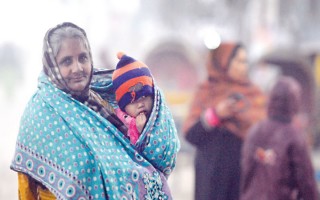Mercury dips to country’s lowest
The lowest ever temperature of the country’s history was recorded at 2.6 degrees Celsius in Panchagarh on Monday, as a cold wave continued sweeping over the country.
The cold hit kids, elderly people, and the poor and day-to-day earners most and disrupted normal life in the northern districts.
Hospitals in the capital and elsewhere in the country were facing a rush of patients suffering from respiratory infections, pneumonia, bronchiolitis, diarrhoea and other diseases caused by cold.
The Met Office recorded the lowest ever temperature of the country’s history at 2.6 degrees Celsius at Tetulia upazila in Panchagarh Monday morning, said meteorologist Abdur Rahman of Bangladesh Meteorological Department.
Earlier, the lowest temperature in the country was recorded at 2.8 degrees Celsius at Srimangal in Moulvibazar in 1968, he said.
Besides, the Met Office recorded 2.9 degrees Celsius at Saidpur and 3 degrees Celsius at Dimla in Nilphamari, 3.1 degrees Celsius at Rajarhat in Kurigram, 3.2 degrees Celsius in Dinajpur, 4 degrees Celsius at Badalgachi in Naogaon, 4.9 degrees Celsius in Rangpur, 5.3 degrees Celsius in Rajshahi, 5.4 degrees Celsius in Chuadanga, 5.5 degrees Celsius at Ishwardi in Pabna and Bogra, and 5.6 degrees Celsius in Jessore.
A severe cold wave continued sweeping over Rangpur and Rajshahi divisions and the regions of Tangail, Srimangal and Chuadanga. A mild to moderate cold wave was blowing over Mymensingh and Barisal divisions, rest parts of Dhaka, Sylhet and Khulna divisions and the regions of Sandwip, Sitakunda, Comilla and Noakhali and it might continue, according to Met Office.
The lowest temperature in Dhaka was recorded 9.5 degrees Celsius Monday morning, said the Met Office.

Monkeys huddle together to ward off the chill of cold wave sweeping the country. The photo was taken at Dhaka Zoo in the capital on Monday. — Sony Ramany
Meteorologist Abdur Rahman said the trend of the low temperature might continue until Wednesday.
Doctors said that hospitals were facing a great rush of patients suffering from respiratory infections, pneumonia, bronchiolitis, diarrhoea and other diseases caused by cold weather.
Parents with their children were seen in long queues at the outpatients’ departments in hospitals in Dhaka and elsewhere across the country Monday morning while indoor paediatric wards accommodated patients double to triple their capacities.
The number of elderly people seeking treatment for chest diseases at the outpatients departments of hospitals also increased.
National Health Crisis Management Centre said that at least five people died of to cold infections between November 2017 and January 8, 2018.
At least 9,138 others suffered from acute respiratory infection and diarrhoea during the period, it said.
In the first week of January, at least 506 people suffered from acute respiratory infection and 1,675 others suffered diarrhoea.
Parents seeking treatments of hundreds of kids were found at paediatric outpatients’ department of Dhaka Medical College Hospital Monday morning.
Towards midday, over 350 children, mostly suffering from cold-related diseases, were seen waiting with tickets to get treatments at the department.
At normal times, treatment seeking children’s number at the outpatient department does not exceed 180, doctors said.
Paediatric resident physician at the hospital Rajesh Majumdar said that about 80 per cent of the children brought these days were suffering from acute respiratory infections.
Child patients suffering from diarrhoea caused by cold weather virus accounted for the second highest number of treatment seekers at the paediatric outpatient department, he said.
Each of the beds in wards for children below five was seen occupied by two or three children.
Paediatric professor Manisha Benarjee said that they could not accommodate the huge rush of children and allowing two or three children in each bed.
Acute respiratory infection and pneumonia were the most common ailments in the children, she said.
Rajesh advised parents to keep their children in warm clothes, avoid going out of home, keep the door and windows closed, avoid daily bathing and avoid applying use of oil in the head and chest, as it congested coughs.
He said that the children should be given honey and tulsi extracts to ease coughs.
The number of elderly patients has also increased to twice that of normal time, said doctors.
Medical officer of respiratory diseases Debashish Bhowmick said that most of the patients were of above 60 and they were suffering from respiratory tract infection and asthma.
He said that at least 160 elderly patients took treatment for chest diseases at the DMCH outpatient department although about 60 such patients visited at normal time.
New Age correspondents in northern districts reported that the sun remained invisible in most districts in past few days paralysing the life of the people.
The low-income group mainly daily wage earners –– the farm labours, rickshaw pullers and vendors –– became the worst sufferers.
People living in the char areas beside Teesta, Brahmputra, Dharla, Atrai and Padma river basins were the most sufferers. Thousands of people in the region were passing days miserably with shortage of warm clothes.
New Age correspondents across the country including in Rajshahi, Panchagarh, Jessore, Dinajpur, Netrokona and Kurigram reported that the cold wave brought miseries to the poor, particularly farmers, rickshaw-pullers and other day-to-day earners.
Children and elderly people were the worst victims of the cold in the districts.
People were trying to avoid going out, but the homeless people were shivering in rail stations, bus stops and other makeshift shelters.
News Courtesy: www.newagebd.net











